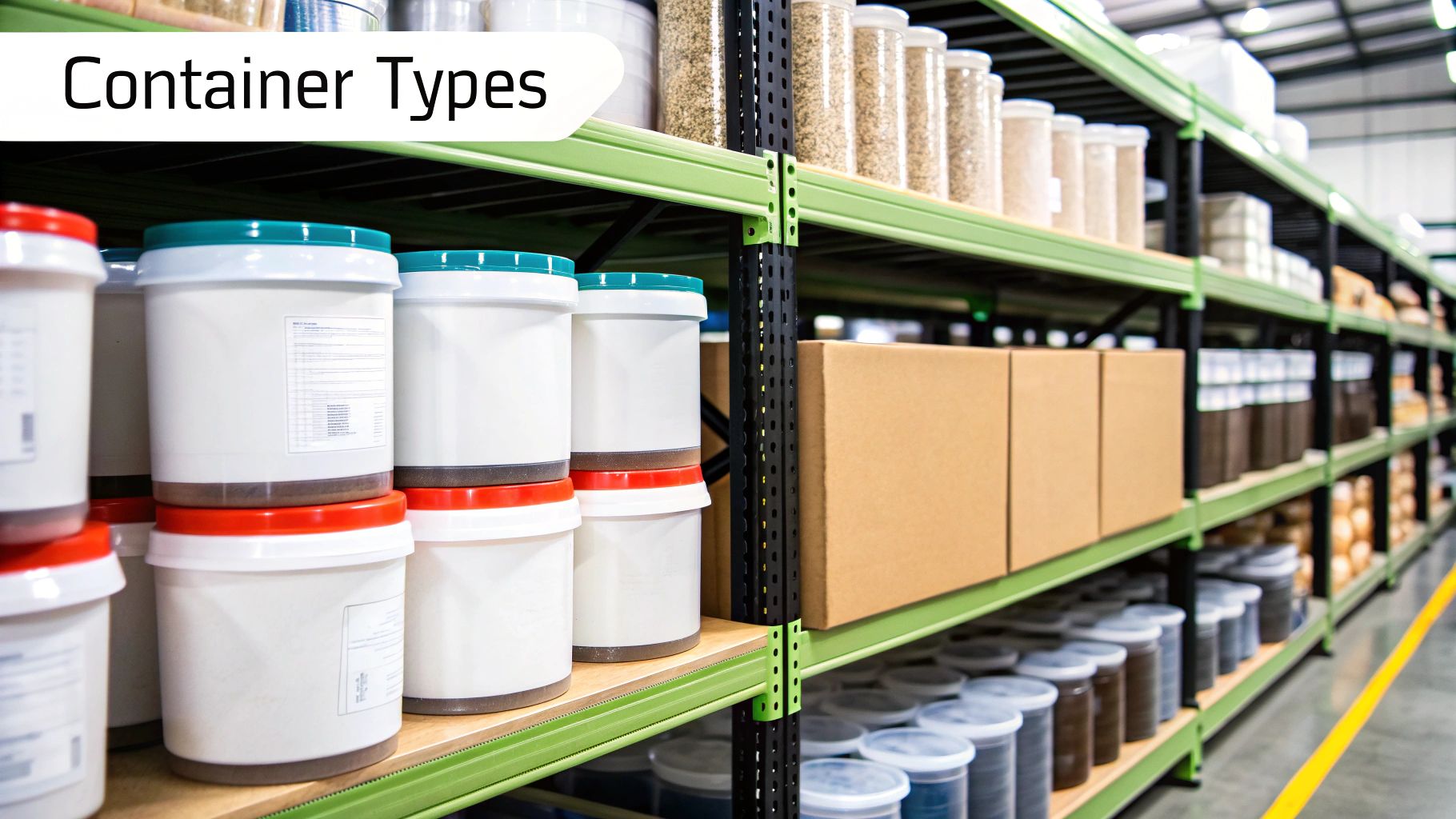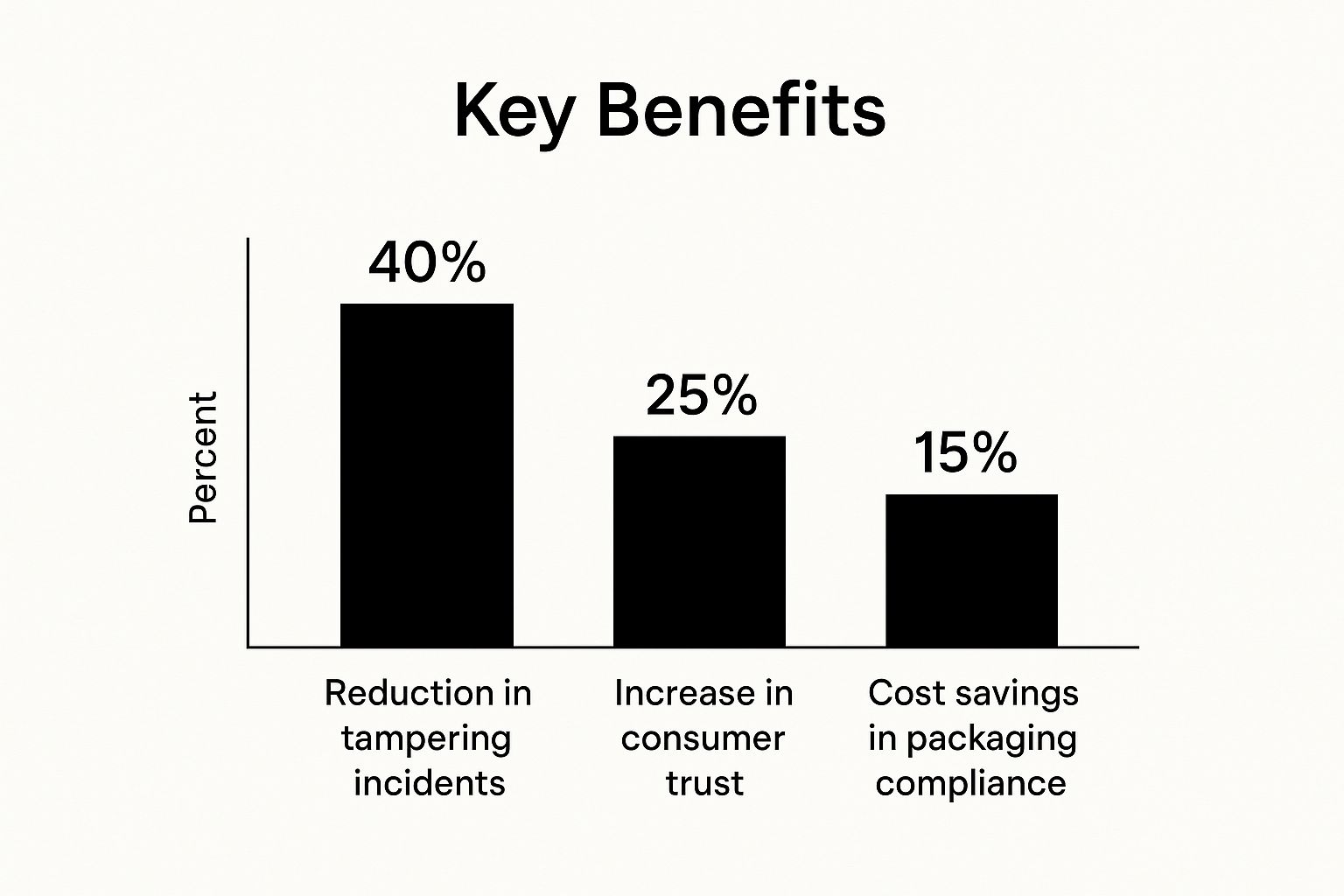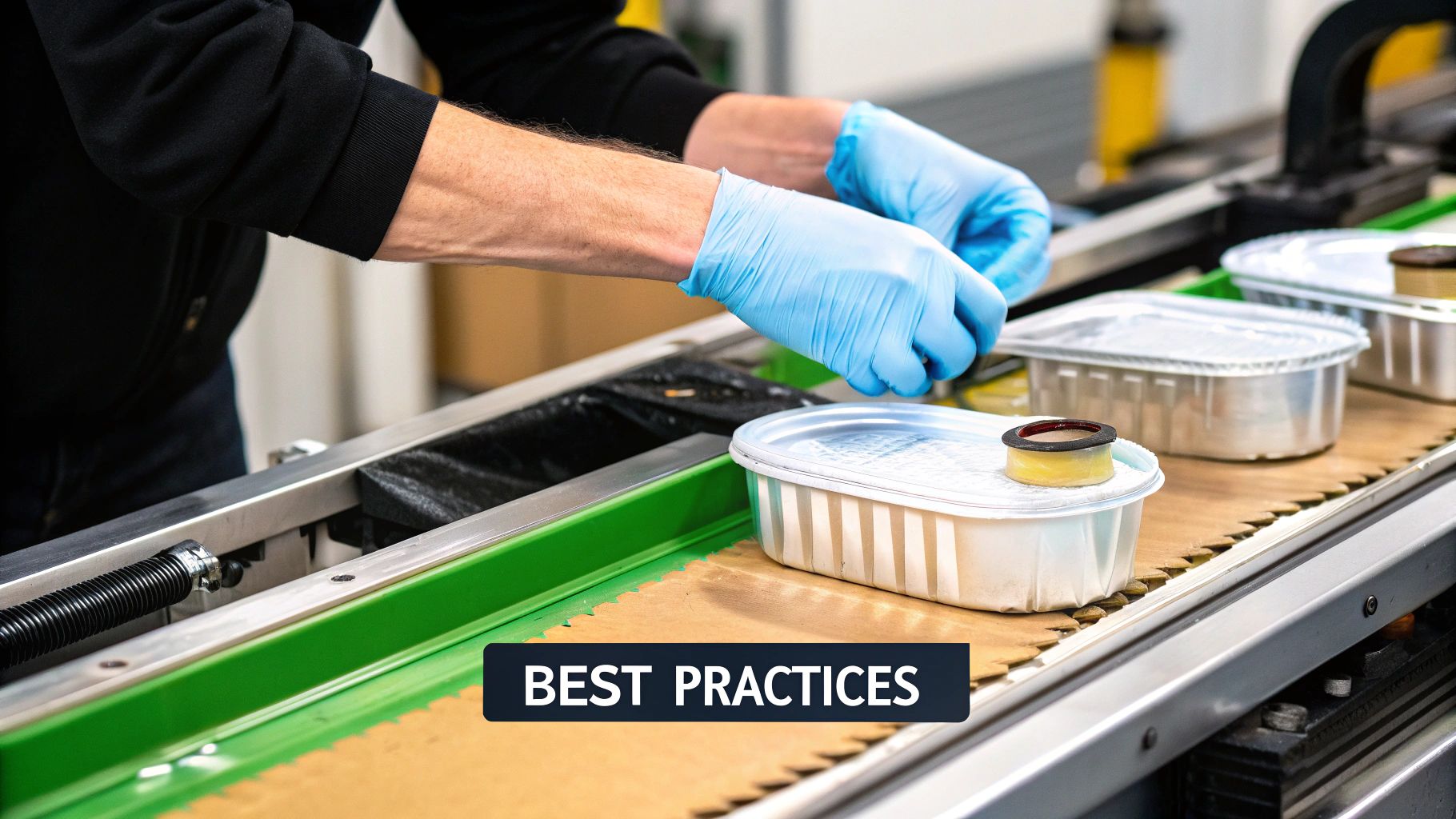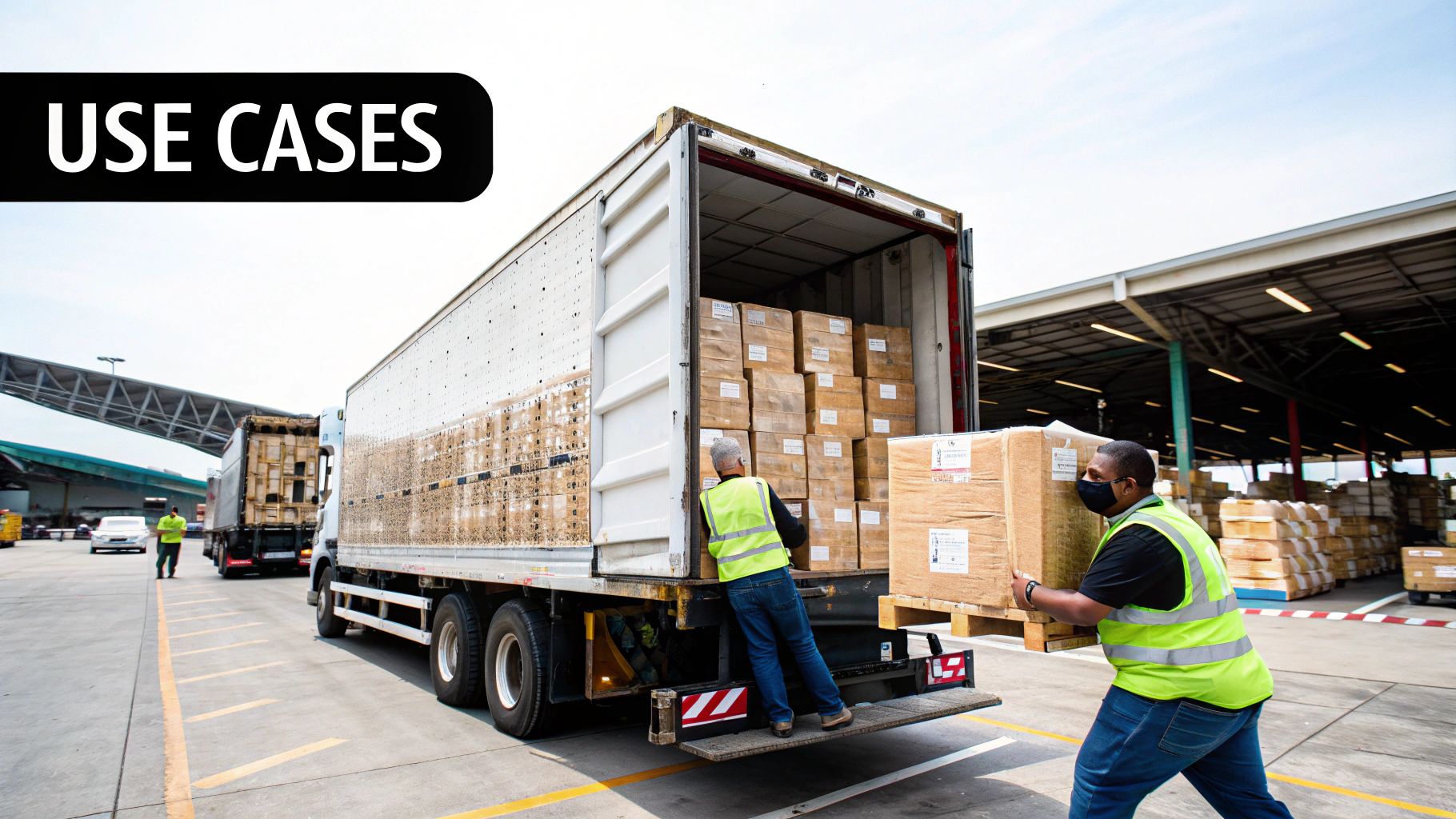Understanding Why Tamper Evident Containers Matter
Product security is incredibly important in today’s competitive market. Tamper evident containers play a vital role in protecting goods and earning consumer trust. These specialized containers offer immediate visual cues if someone has tried to open the product.
This visible reassurance acts as a silent guardian, quietly communicating a strong commitment to quality and safety. It builds brand confidence and reinforces the product’s value to the consumer. This sense of security is paramount, especially in industries where product integrity is crucial.
The Psychology of Tamper Evidence
Imagine buying medicine or a premium food item and finding the seal broken. That feeling of unease and distrust is exactly what tamper evident containers prevent. They offer tangible assurance that the product is untouched and safe. This psychological reassurance is a major factor in consumer purchasing decisions, especially for sensitive items like pharmaceuticals, food, and valuable goods.
Industry-Specific Applications
Tamper evident containers are used across many industries. In pharmaceuticals, they ensure medication safety and efficacy. The food industry uses them to preserve freshness and prevent contamination. E-commerce businesses rely on them to protect shipments in transit. The increasing need for these secure solutions is clear in market trends. The global tamper evident packaging market was valued at USD 2.34 billion in 2025. It’s projected to reach about USD 4.76 billion by 2034, growing at a CAGR of 8.22%. Finding the right balance between cost and security is critical, taking into account the specific risks of each industry.
The Real-World Impact
Tamper evident containers are a smart investment in brand protection, consumer loyalty, and product integrity. They’re no longer an optional extra, but a crucial part of a strong security strategy. This proactive approach reduces potential risks. Ultimately, it improves customer satisfaction and brand trust, strengthening a company’s market position.
Navigating Container Types And Security Technologies
Tamper evident containers come in many forms, each with varying degrees of security. This allows businesses to choose the best strategy for their individual needs. Let’s explore the available options, from simple tamper evident seals to sophisticated solutions like smart packaging.
Mechanical Tamper Evident Solutions
Traditional tamper evident methods use physical mechanisms that break when opened. Here are a few examples:
- Shrink Bands: Plastic bands shrink-wrapped around a container. A broken band clearly shows evidence of tampering.
- Tamper Evident Tapes: These special tapes leave a residue or tear when removed, indicating the container has been opened.
- Breakaway Seals: Plastic or metal seals that must be broken for product access.
- Destructive Labels: Labels that tear or break apart when someone tries to remove them.
These mechanical solutions are affordable and easy to use.
However, they may not be as secure as more advanced technologies. Some seals can be carefully removed and reapplied, potentially compromising the security.
Advanced Security Technologies
Advances in materials science have greatly improved container security. Some examples include:
- Heat-Sensitive Materials: These materials change color when exposed to heat, signaling possible tampering.
- Holographic Elements: Difficult-to-copy holographic labels or seals provide strong authentication.
- RFID Tags: Radio-frequency identification tags embedded in the packaging allow tracking and authentication throughout the supply chain.
These advanced options offer increased security and can integrate with digital systems for real-time monitoring. This gives businesses better visibility and control over product security.
This extra security comes at a higher cost, but it’s often worthwhile for valuable or sensitive products.
Choosing The Right Solution: A Cost-Benefit Analysis
Choosing the right tamper evident container means balancing the level of security needed with the cost. The infographic below shows the potential return on investment for implementing tamper-evident solutions:
The data reveals substantial benefits. Tamper evident packaging leads to a 40% reduction in tampering incidents, a 25% boost in consumer trust, and a 15% cost saving in packaging compliance. This shows that investing in tamper evident containers can improve security, boost customer perception, and potentially lower costs related to product loss and liability.
Simpler solutions may be enough for low-risk products. However, high-value or sensitive goods often justify the cost of more advanced features. This careful approach lets businesses optimize security spending while ensuring adequate protection.
To further illustrate the various options available, let’s examine a comparison of different tamper-evident solutions:
Tamper Evident Container Types and Features Comparison
| Container Type | Security Method | Primary Applications | Security Level | Cost Range |
|---|---|---|---|---|
| Shrink Bands | Heat-shrunk plastic band | Food, beverages, and pharmaceuticals | Low | Low |
| Tamper Evident Tapes | Adhesive residue or tearing upon removal | Boxes, cartons, envelopes | Low to Medium | Low |
| Breakaway Seals | A plastic or metal seal that breaks upon opening | High-value electronics, medical devices | Medium | Medium |
| Destructive Labels | Tears or fragments upon removal | Product authentication, warranty protection | Medium | Medium |
| Heat-Sensitive Materials | Color change upon heat exposure | Food, pharmaceuticals | Medium to High | Medium to High |
| Holographic Elements | Difficult-to-replicate holographic image | Luxury goods, pharmaceuticals | High | High |
| RFID Tags | Radio-frequency identification | Supply chain tracking, anti-counterfeiting | High | High |
This table highlights the diverse range of tamper-evident solutions and helps to visualize the relationship between security level, application, and cost. Choosing the appropriate container type depends on a careful assessment of the specific needs of the product being protected. While basic solutions like shrink bands and tamper-evident tape offer a visual deterrent at a low cost, higher-security options like RFID tags and holographic elements provide significantly greater protection for sensitive or high-value goods.
Real-World Applications Across Industries
Tamper evident containers are vital across many industries, each with its own security requirements. From pharmaceuticals to food and e-commerce, the right container is key for maintaining product integrity and building consumer trust. This section explores how these containers are used in various sectors and the important factors for successful implementation.
Pharmaceuticals: Ensuring Safety and Compliance
In the pharmaceutical industry, tamper evident containers are crucial for patient safety. They ensure medications haven’t been altered or contaminated, preserving their effectiveness and preventing harmful consequences. Strict regulatory requirements often mandate specific tamper evident features, ensuring compliance and minimizing legal risks. This careful approach underscores the industry’s commitment to patient well-being and strict quality standards.
Food and Beverage: Preserving Freshness and Preventing Contamination
Food companies face the challenge of preserving freshness and preventing contamination. Tamper evident containers address both. They maintain the quality and safety of food products, reassuring consumers of their safety. This is especially important for perishable goods, where even minor tampering can lead to spoilage and health hazards.
E-Commerce: Protecting Shipments and Building Trust
For e-commerce businesses, tamper evident containers protect shipments in transit, reducing losses from theft or damage. This added security safeguards goods and builds customer trust. A secure delivery improves brand reputation and encourages repeat business. Tamper-evident technologies often rely on verifiable seals and labels, which can be managed with document verification software.
In a growing market where product authenticity is paramount, these containers offer vital protection against counterfeiting. The global tamper-proof packaging market reached USD 36.6 billion in 2024 and is projected to reach USD 70.99 billion by 2034. This growth underscores the increasing importance of packaging security.
Emerging Applications: Cannabis, Luxury Goods, and Direct-to-Consumer
Innovation is driving new security measures in emerging markets like cannabis, luxury goods, and direct-to-consumer shipping. Tamper evident containers verify product authenticity, protect premium brands, and assure consumers of quality. This trend reflects a broader move toward increased transparency and security.
Adapting to Industry-Specific Regulations
Regulations significantly influence container selection. Different industries have varying standards that must be met, affecting the required tamper-evident features. Understanding these guidelines is critical for compliance and avoiding penalties. This careful consideration of regulations demonstrates the importance of aligning security with legal obligations. By choosing tamper evident containers that meet industry needs and regulations, businesses protect products, build consumer confidence, and strengthen their brand.
Measuring The True ROI Of Container Security
Tamper evident containers provide more than just product protection. They offer a significant boost to a company’s bottom line that extends far beyond the initial investment. Let’s explore the measurable business value these containers deliver.
Reducing Liability and Associated Costs
One of the most substantial ROI factors is the mitigation of liability costs. Tamper evident containers minimize the chances of product tampering, thus reducing the potential for expensive legal issues and product recalls. This proactive safety approach can free up resources for other areas of the business. This is especially critical for industries like pharmaceuticals and food, where product safety is paramount.
Decreasing Theft and Product Loss
Tamper evident packaging also acts as a theft deterrent, decreasing product loss throughout the supply chain. This directly benefits inventory management and reduces shrinkage. Businesses using these containers often see a noticeable drop in lost or damaged products due to tampering. This allows for tighter inventory control and optimized supply chain operations. For businesses handling high-value goods, these security measures can result in considerable cost savings.
Enhancing Brand Reputation and Consumer Trust
While more challenging to quantify, the positive effect of tamper evident containers on brand reputation is undeniable. Consumers are more inclined to trust and buy products that are clearly protected. This increased trust fosters stronger brand loyalty and repeat business, contributing to long-term revenue growth. A solid reputation for product safety provides a competitive edge, attracting and retaining customers in a competitive marketplace.
Calculating and Justifying the Investment
Creating a compelling business case for tamper evident containers requires considering both tangible and intangible benefits. A thorough cost-benefit analysis should account for reduced liability, decreased theft, and the positive influence on brand reputation. Measuring improvements in consumer confidence can be complex, but various frameworks can help quantify these benefits. These include tracking customer feedback, analyzing sales data, and monitoring changes in market share, all of which help demonstrate the value of investing in container security.
Tracking Ongoing Success and Adapting to Change
Using tamper evident packaging isn’t a one-time solution; it requires continuous monitoring and adaptation. Tracking key metrics like tampering incidents, product returns, and customer satisfaction helps evaluate the chosen solution’s effectiveness. Regularly reviewing and updating security measures ensures the program’s long-term success.
This adaptable approach allows companies to stay ahead of emerging threats and maintain a high level of product security. By diligently measuring the true ROI of container security, businesses can justify the investment and showcase the significant advantages of safeguarding their products and their brand.
Smart Technology Integration and Advanced Features
Tamper-evident containers have evolved far beyond basic seals and shrink wrap. The future of tamper evidence is surprisingly high-tech, incorporating smart technology for real-time monitoring and enhanced security.
QR Codes, NFC, and Blockchain: Multi-Layered Authentication
Imagine verifying the authenticity of your medication by simply scanning a QR code on the bottle. Or, picture tapping your smartphone against a container to access its complete history. This is the reality of integrating QR codes and Near Field Communication (NFC) chips into tamper-evident containers.
These technologies provide multi-layered authentication, making counterfeiting incredibly difficult. Blockchain technology adds another layer of security, creating an immutable record of a product’s journey through the supply chain, increasing transparency and further deterring tampering. This combination offers a powerful defense against counterfeiting.
AI and Machine Vision: Enhanced Detection
Artificial intelligence (AI) and machine vision are revolutionizing tamper detection. These systems analyze images of containers, identifying even the slightest signs of tampering that might go unnoticed by the human eye.
This automated inspection increases efficiency and reliability. AI can be trained to recognize minute variations in seal integrity or label placement, significantly improving accuracy and speed. Tamper evident labels play a crucial role. The tamper-evident labels market, valued at USD 20.83 billion in 2025, is projected to reach USD 35.19 billion by 2034. This growth highlights the significant investment in this crucial aspect of tamper-evident packaging.
Smart Labeling for Real-Time Monitoring
Smart labeling solutions elevate tamper evidence. These labels contain sensors that detect changes in temperature, pressure, or other environmental factors, enabling real-time monitoring of a product’s condition.
This constant vigilance allows for immediate alerts if tampering occurs or if a product is exposed to conditions that might compromise its quality. This level of monitoring offers businesses unprecedented control over their products’ safety and integrity.
Separating Value from Novelty
While smart technology offers exciting possibilities, not every advanced feature is necessary. Some may be costly additions with minimal practical benefit.
Businesses should carefully consider which features genuinely enhance security and provide a worthwhile return on investment. Understanding your specific security needs is crucial for selecting features that address them effectively. By differentiating between valuable features and expensive add-ons, companies can develop a cost-effective and highly secure packaging strategy.
Choosing And Implementing The Right Solution
Finding the right tamper evident container involves more than just picking the cheapest option. It’s about striking the perfect balance between security, cost, and practicality. This section offers a practical framework for making informed choices and putting your chosen solution into action effectively.
Defining Your Security Requirements
First, clearly define what you need to protect. What level of security do your products need? Are you mainly worried about deterring casual tampering, or do you need serious protection against sophisticated counterfeiting? For example, over-the-counter medications may only require basic tamper evidence, while high-value electronics or pharmaceuticals need stronger safeguards. This initial assessment is key for selecting the right container.
Evaluating Budget Constraints
Budget is always a factor. While high-security features offer better protection, they also cost more. Balance security needs with what you can realistically afford. You might choose simpler solutions for low-risk products and reserve more advanced technologies for high-value or sensitive items. Prioritizing your spending gets you the most security within your budget.
Considering Operational Realities
Implementation should be smooth and efficient. Consider how different containers will fit into your current processes. Some might need special equipment or training, while others are easy to integrate. Evaluating practical aspects will minimize disruptions. Think about storage space, packaging speed, and compatibility with your current systems. These operational details are crucial for success.
Implementation Best Practices
Rolling out new containers requires a structured plan. Begin with a pilot program to test your chosen solution in a controlled setting. This helps spot any problems and refine your strategy before a full launch. Train your staff on proper procedures for using and inspecting the new containers to maximize effectiveness.
Practical Checklists and Timelines
Create a checklist of important tasks and set realistic timelines. This keeps implementation organized and on track, helping you avoid delays. Establish clear milestones and ways to measure the success of your new security program.
Avoiding Common Pitfalls
A common mistake is neglecting staff training. Even the best security features are useless if implemented incorrectly. Clear communication and proper training are crucial. Another pitfall is focusing only on price. A careful evaluation is key. By considering all these factors, you can choose and implement the right solution for your business.
To help you choose the most appropriate container, use the table below:
Tamper Evident Container Selection Matrix
| Selection Factor | Weight | Evaluation Criteria | Score Range | Key Considerations |
|---|---|---|---|---|
| Security Level | High | Effectiveness against different tampering methods, evidence of tampering clarity | 1-5 (1=Low, 5=High) | Product value, risk assessment, regulatory requirements |
| Cost | Medium | Unit cost, implementation cost, ongoing maintenance | 1-5 (1=Low, 5=High) | Budget constraints, return on investment |
| Industry Requirements | Medium | Compliance with specific industry regulations and standards | 1-5 (1=Low, 5=High) | Pharmaceutical, food, or other industry-specific needs |
| Implementation Complexity | Low | Ease of integration into existing workflows, staff training requirements | 1-5 (1=Low, 5=High) | Operational impact, available resources |
This matrix provides a starting point for evaluating different tamper-evident containers. By weighing these factors, you can identify the container that best suits your specific circumstances. Remember to adjust the weights based on your unique priorities.
What’s Coming Next In Container Security
The world of tamper-evident containers is constantly changing, thanks to evolving technology and increasing demand for better security. Forward-thinking businesses are already adapting to these shifts, understanding the need to stay ahead.
Sustainability Meets Security
A major trend is the increase in eco-friendly tamper-evident packaging. Consumers are more aware of environmental concerns than ever before. Businesses are developing sustainable packaging that doesn’t compromise security. This includes exploring new materials and designs that reduce waste without sacrificing tamper-evident effectiveness. For instance, some companies now utilize recycled plastics and biodegradable materials.
The Internet of Things and Real-Time Monitoring
The Internet of Things (IoT) is changing how we interact with products, and tamper-evident containers are no different. Integrating IoT allows real-time monitoring and automated alerts. Businesses can instantly know if a container has been compromised, enabling a quick response and minimizing potential issues. Imagine pharmaceutical shipments with sensors that track temperature and location, instantly alerting the distributor of any problems.
Regulatory Changes and Industry Standards
New regulatory changes will likely influence container requirements across several industries. Leading manufacturers are anticipating these changes and are already developing solutions that comply with future standards. This proactive approach ensures compliance and reduces disruption. Staying informed about regulatory updates is vital for strategic decision-making regarding container security.
The Next Generation of Tamper Evident Technology
Developments in artificial intelligence (AI), nanotechnology, and materials science are creating opportunities for ultra-secure containers. Artificial Intelligence algorithms can analyze sensor data for subtle signs of tampering. Nanomaterials offer potential for stronger, more tamper-resistant seals. These advancements promise improved security and user-friendliness. Imagine a container with a nanoscale coating that changes color if tampered with, providing a clear visual indicator. New tamper-evident designs, like the TamperFlag™ container from Novolex, have built-in flags that pop up when opened, offering a clear sign of tampering and boosting consumer trust.
Looking to improve your takeout packaging with tamper-evident options? Explore the choices at MrTakeOutBags.com for high-quality, customizable packaging that prioritizes both security and presentation.








Comments are closed.